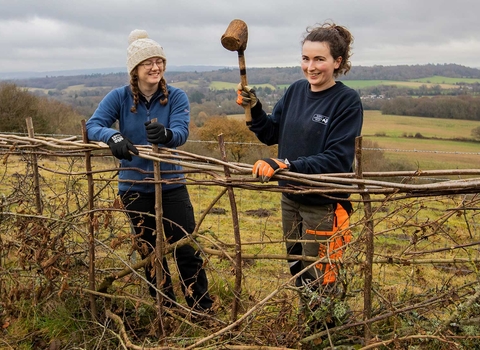I’m Luke Parham and I’m a Nature Space Officer with Surrey Wildlife Trust.
Thanks to a recent internal transfer, I have now joined the Hedgerow Heritage project. Prior to this move, my first and only encounter with hedgerow management came whilst I was a volunteer at RSPB Pulborough Brooks. Here, I was able to spend a day helping to lay (the process of partially cutting through and then bending the stems to create structure and continuity) one of the hedges there, which was enough for me to want more. Having previously focussed on lowland heath management in the Thames Basin Heath area it is exciting to be given the opportunity to reignite that spark, learn how to manage a new type of habitat and gain new skills.
More importantly, of course, it’s going to be fun helping local communities and volunteers engage with the wonderful world of hedges in their local areas, and equipping them with the skills, knowledge and passion to manage and conserve hedgerows for future generations
Having helped deliver hedgerow survey training workshops to our volunteers at Clandon woods Natural burial ground, I increasingly understand the importance of hedges for people and wildlife alike. Hedgerows are the UK’s largest priority habitat. With a combined range of around half a million miles, they provide support to over 2,000 different species making them vital nature reserves within the landscape. 130 of these species are listed on the UK Biodiversity Action Plan for priority species that include 10 species of lichen, 72 species of invertebrates, 5 species of Amphibian and reptiles, 11 species of mammals and 20 species of birds.
However, our hedgerows are under threat and have been since the mid-20th century. This is largely due to the intensification of agriculture that was carried out after WW2 in order to improve efficiency and food security, causing an estimated 118,000 miles of hedgerows to disappear from our countryside. The effects of agricultural chemicals, poor management practices and neglect has resulted to around 60% of remaining hedgerows being considered in ‘poor structural condition’.
Our hedgerows are in desperate need of assistance. It is up to us to help create new hedgerows, restore those that need help to return to a good structural condition, and maintain those that currently are in a good condition by using and promoting good practice management techniques.
Ifyou seek to learn more, in the next part I seek to answer the following questions:
(1) What makes a hedgerow?; (2) What are the benefits of hedgerows to wildlife and people?; and (3) How can I help?



